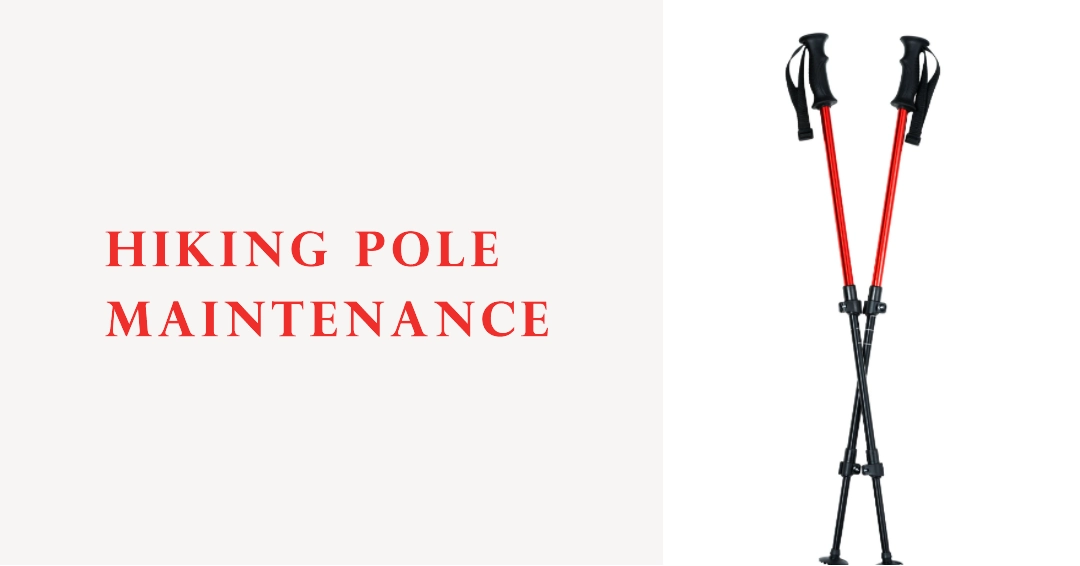Table of Contents
Some links on posts are affiliate links and will earn us a commission from qualifying purchases
Hiking poles, also known as trekking poles, have become an essential accessory for both professional and amateur hikers. They provide stability, reduce the impact on your joints, and help distribute weight during uphill and downhill hikes.
Just like any other piece of gear proper hiking pole maintenance is essential for ensuring maximum life and performance. This guide will cover the storage and cleaning techniques as well as periodic checks for wear and tear, and tips for repairing or replacing worn components, extending their lifespan and ensuring they’re always ready for your next adventure.
Proper Storage of Your Hiking Poles
Long-term storage is crucial in maintaining the lifespan of your hiking poles. To store them correctly, follow these steps:
- Collapse the poles to their shortest length to minimize any bending pressure on the joints.
- Ensure the poles are dry before storing to prevent rusting or corrosion. If you’ve used them for a hike, let them air-dry outdoors or in a cool, dry place.
- Avoid direct sunlight or excessive heat to reduce the wear on the pole’s material.
- Store them in a cool, dry place away from humidity and dampness.
How do you store Hiking Poles while hiking?
Hiking poles can be an essential tool for any hiker, providing stability and support on even the toughest of trails. But when they’re not in use, how do you store them?
Many rucksacks now come with dedicated pockets inside, or straps and loops on the outside, for hiking poles. Simply slide your poles into the straps to keep them out of the way while you hike or collapse the poles and carry them in your rucksack. These are both great methods, but will be adding a small amount to the weight of your rucksack.
Regular Cleaning of Your Hiking Poles
Taking time to clean your hiking poles will not only make them look better but also ensure their longevity. Here’s how to clean them correctly:
- Disassemble the poles according to the manufacturer’s guidance. If unsure, check the user manual or search online for instructions specific to your model (see table below).
- Use warm, soapy water to clean the pole sections, handles, and straps. Avoid using harsh chemicals or abrasive materials that may damage the poles.
- If your hiking poles have foam or cork grips, they can absorb dirt and sweat over time. To clean them, use a mild detergent or rubbing alcohol. You’ll not only maintain hygiene but also restore the original look and feel of your grips.
- Pay special attention to the threaded locking mechanisms as dirt can accumulate and affect their performance. Use a small brush or toothbrush to clean them thoroughly.
- Dry the poles with a clean cloth or air-dry them in a well-ventilated area. Make sure all components are completely dry before reassembling them.
- Be extra gentle with carbon fibre poles, as hey more susceptible to scratches. Use a damp cloth with a mild soapy solution and avoid harsh scrubbing. Dry completely with a microfibre towel.
Disassembly and internal care:
For deeper cleaning and to maintain internal mechanisms, disassembling your poles is key. Check with the manufacturer’s website, or call them directly for advice, but generally the process involves unscrewing the locking mechanisms and carefully separating the sections.
Once apart, pay special attention to the locking mechanisms:
- Twist-Lock: Look for dirt or debris clogging the mechanism. If necessary, use a soft brush and soapy water to clean it out. Apply a small amount of lubricant (specific to your pole model) to the threads for smooth operation.
- Lever-Lock: Clean the levers and cams with a damp cloth. Check for any cracks or chips that could compromise their function.
Remember, thorough drying is crucial before reassembling your poles. Store them in a cool, dry place with the sections slightly extended to prevent warping.
Periodic Checks for Wear and Tear
Inspect your hiking poles regularly, especially before and after long hikes. Look out for the following signs of wear and tear:
- Check the pole’s locking system for secure and smooth functioning. Loose or shaky poles can lead to accidents and create additional stress on your joints.
- Inspect the tips or baskets for excessive wear, breakage, or cracks. These should be replaced when worn to maintain optimum traction and performance.
- Verify the integrity of your pole’s material, whether it is aluminum, carbon fibre, or any other type. Look for any cracks, bends, or damage that might compromise its structural integrity.
Tailoring Your Maintenance Routine for the type of hiking you do
The type of terrain and conditions you frequent will influence your maintenance needs:
- Rugged Terrain: Expect faster wear and tear on pole tips and baskets. Inspect them regularly for signs of damage and replace them promptly. These are generally available from the manufacturers direct and don’t cost too much.
- Wet Conditions: Pay extra attention to drying your poles after use. Moisture can lead to rust on metal components and weaken locking mechanisms.
Repairing or Replacing Worn Components
If you notice any wear or damage to specific components, it’s important to address the issue promptly to prevent further damage. Here’s how:
- For worn tips or baskets, most hiking poles have replaceable options. Check the manufacturer’s website for the appropriate replacements, and follow their instructions for installation.
- If your poles have a flick-lock or twist-lock system, check if the locking mechanism can be tightened or adjusted. If the issue persists, consider investing in a replacement lock or contacting the manufacturer for assistance.
- Serious issues like cracks or bends in the pole’s shaft might warrant buying a new pole. Try weighing the cost of repair or replacement, and consider the value of investing in a new set.
Troubleshooting Common Pole Woes
- Wobbly Poles: This could indicate loose locking mechanisms. Tighten them according to the manufacturer’s instructions. If the problem persists, consult a professional for repairs.
- Broken Baskets: Replace them immediately to maintain traction and prevent damage to the pole tips.
- Malfunctioning Locks: Depending on the issue, cleaning, lubrication, or tightening might be the solution. If the problem persists, consult the manufacturer’s warranty information or seek professional repair.
Popular Manufacturers advice
Please find below links to some of the popular manufacturer’s websites for hiking pole maintenance:
| Brand | Web address |
| Leki | Leki Product Care |
| Trekology | Trekology blog post |
| Trekrite | Trekrite Product Support |
| Black Diamond | Black Diamond Product FAQs |
Conclusion – Hiking pole maintenance tips
Taking proper care of your hiking poles is absolutely vital to ensure they stay in top-notch condition and provide you with the support you need on your outdoor adventures.
By following the simple yet effective steps outlined in this comprehensive guide, you can prolong the life of your hiking poles and ensure they remain reliable companions for years to come. Investing just a little time in regular maintenance today can save you from the hassle and expense of having to replace your beloved hiking poles down the line.
Recent Posts
Choosing the Perfect Hiking Poles: A Comprehensive Guide to Features and Designs
Hiking is a fantastic way to stay healthy, explore the great outdoors, and challenge yourself physically and mentally. Along with appropriate footwear, backpack, and clothing, a reliable pair of...
I've been wondering about buying some walking poles for a while, but don't really know anyone who uses them. So I've had no-one to ask about them in person and as such had to do my own...


